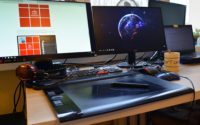How to choose the right monitor for graphic design
 If you are a professional graphic designer, student or just a hobbyist, one of most important things is proper equipment – especially, a good monitor. In this article you will find information to which parameters you should pay attention.
If you are a professional graphic designer, student or just a hobbyist, one of most important things is proper equipment – especially, a good monitor. In this article you will find information to which parameters you should pay attention.
What features and functions should the graphic monitor have?
- High resolution and large screen size
- IPS matrix with the appropriate coating
- Monitor with Adobe RGB color space
- Advanced calibration tools
- Additional amenities
High resolution and large screen diagonal
As with universal monitors, the monitor for graphics today has at least a 24-inch screen. The bigger it is, the easier it will be for you to lay out your work area with all the necessary graphics software tools. The only limitation here is the distance between your eyes and the monitor. The screen should be so large that you can look at the whole of it, without having to move your head.
When it comes to resolution, the absolute minimum for graphic designers is currently the screen with FullHD resolution – 1920 × 1080 pixels. Many professionals, when they really need a lot of workspace, connect two FullHD monitors side by side. In this variant, models with a very thin frame work best.
IPS matrix with the appropriate coating
What is the IPS matrix? There are three basic types of panels: TN, IPS, VA.
TN panel
TN panel monitors are the most popular on the market.
TN matrices are characterized by poor color reproduction, and the saturation of colors gives an unnatural impression. The contrast is also not the best, which often deviates from the manufacturer’s declarations, as well as viewing angles, which are very narrow (although thanks to the introduction of technological changes, they have been able to increase them).
However, the great advantage of TN matrices is very short response time, thanks to which there is no smudging effect, and thus they are perfect for dynamic film and computer scenes.
IPS panel
IPS Matrices have a lot of advantages, which allows you to get a great (though not perfect) image quality. It is influenced by a great reproduction of colors (although the coverage of the color space depends on the model and price shelf) and wide viewing angles in horizontal and vertical. Due to increasing the refresh rate of the image, producers were forced to improve the response time. IPS panels are characterized by low contrast, as well as poor black, which very often resembles dark gray. Also they are much more expensive than TN panels.
The IPS matrix is used in monitors for graphic designers, but also in office equipment. Thanks to wide viewing angles, as well as good color reproduction, they are suitable for watching movies with the whole family.
VA panel
VA panels are a solution in terms of quality, as well as prices between TN and IPS panels.
In terms of image quality, VA matrices are better than TN and slightly worse than IPS. They have a good response time and wide viewing angles. Their greatest asset is high contrast and very good image detail. VA matrices are used in office work, but also in graphic programs. They are used by manufacturers of high-end monitors designed for professionals, although the best color reproduction still offers IPS matrices.
Which matrix coating?
You must also choose the appropriate matrix coating. The shiny coating will better reflect all the colors, but it can be tiring – it reflects the light more strongly and, as a consequence, tones the eyesight. So if you have a desk in a dark place where light reflections do not bother you, you can buy a screen with a glossy coating. However, if you have a desk near the window and your eyes are tired quickly, buy matte coating matrix.
Monitor with Adobe RGB color space
A modern monitor for graphics is characterized above all by faithful reproduction of colors. They are provided, among others, by the appropriate type of matrix, the type of backlight used and the coverage of the color space. Currently, most monitors feature a 100% coverage of the sRGB space. However, the monitor for professional graphics should display the AdobeRGB color palette. Ideally, if our monitor will be able to self-calibrate or have appropriate certificates.
Advanced calibration tools
Software calibrator, color and gamma correction tools, brightness and contrast adjustment – all this now allows you to adjust the screen image to your preferences. In addition, the hardware calibrator is increasingly included in the basic equipment of the monitor.
Additional amenities
The basic parameters of work are the most important, but the details also determine the comfort of work. Below you will find some additional features and functions that should not be missing from professional equipment.
Ergonomic foot – foot with horizontal and vertical tilt adjustment, height change and the ability to work in portrait mode allows you to place the screen in the most convenient position.
USB connector – of course we have them in our computer, but not everyone wants to bend to it every time we want to connect a flash drive. Even a cheap monitor for graphics can have such a connector.
Screen covering hood – available in more advanced and more expensive models, which significantly affects the comfort of work. It protects the surface of the screen from external lighting, which, depending on the intensity and color, affects the color characteristics of the matrix. The hood also allows you to reduce the brightness settings, thus reducing energy consumption by up to 40%.
Brightness stabilization – a very useful function that instantly adjusts the brightness when the monitor is turned on or after leaving the sleep state. It allows you to quickly resume work
Thank you, Peter, for helping me to write this post!



